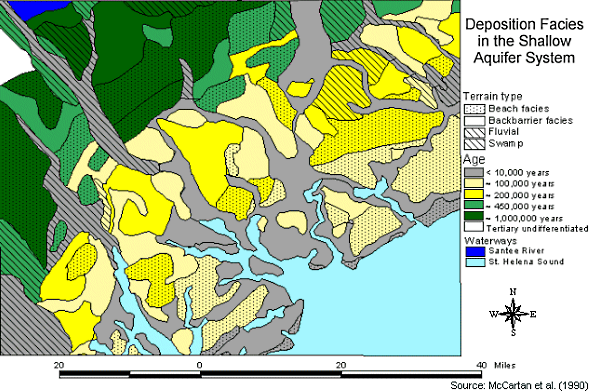Characterization of the Ashepoo-Combahee-Edisto (ACE) Basin, South Carolina
Ground water

Ground water in the ACE Basin is found in six aquifer systems and three principal confining beds in the lower coastal plain (Aucott et al. 1987). The principal aquifer systems are Cape Fear, Middendorf, Black Creek, Tertiary Sand, Floridan, and Shallow. Each system has unique and diagnostic combinations of lithography, hydraulics, and water chemistry that determine their potential use by humans. The only aquifers in use today are the Tertiary Sand, Floridan, and Shallow. The Tertiary sand and Floridan aquifer systems are the principal sources of domestic, commercial, and public water supplies, and well yields as great as 1,900 L/min (500 gpm) are reported for most of the basin. The shallow aquifer system is the least consistent with respect to well yield. However, wells drilled in areas underlain by beach facies provide enough water for domestic supply and produce up to 190 L/min (50 gpm) locally. Treatment is likely to be required for hardness in water from the Tertiary sand and Floridan aquifer systems and for dissolved iron in water from the Floridan and Shallow systems. Fluoride, sodium, bicarbonate, and chloride increase coastward in all but the Shallow system. The Shallow aquifer produces water with low-dissolved solid concentrations except where it contacts saltwater marshes and streams. Saltwater intrusion occurs in the Floridan aquifer system at Edisto Beach owing to water-level declines. Chloride concentrations in the Floridan aquifer at Edisto Beach can be expected to increase with time owing to pumping-induced upcoming and saltwater intrusion. The Edisto Beach and Walterboro public water supply systems are the largest users in the ACE Basin study area.
